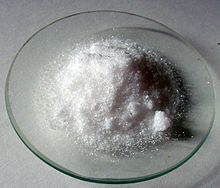
| |

| |
| Names | |
|---|---|
| IUPAC name
Sodium molybdate
| |
| Other names
Disodium molybdate
| |
| Identifiers | |
| |
3D model (JSmol)
|
|
| ChEBI | |
| ChemSpider | |
| ECHA InfoCard | 100.028.683 |
| EC Number |
|
PubChem CID
|
|
| RTECS number |
|
| UNII |
|
CompTox Dashboard (EPA)
|
|
| |
| |
| Properties | |
| Na2MoO4 | |
| Molar mass | 205.92 g/mol (anhydrous) 241.95 g/mol (dihydrate) |
| Appearance | White powder |
| Density | 3.78 g/cm3, solid |
| Melting point | 687 °C (1,269 °F; 960 K) |
| 84 g/100 ml (100 °C) | |
Refractive index (nD)
|
1.714 |
| Hazards | |
| NFPA 704 (fire diamond) | |
| Flash point | Non-flammable |
| Lethal dose or concentration (LD, LC): | |
LD50 (median dose)
|
4000 mg/kg (rat, oral)[1] |
LC50 (median concentration)
|
>2080 mg/m3 (rat, 4 hr)[1] |
| Safety data sheet (SDS) | External MSDS |
| Related compounds | |
Other anions
|
Sodium chromate Sodium tungstate |
Other cations
|
Ammonium molybdate |
Except where otherwise noted, data are given for materials in their standard state (at 25 °C [77 °F], 100 kPa).
| |
Sodium molybdate, Na2MoO4, is useful as a source of molybdenum.[2] This white, crystalline salt is often encountered as the dihydrate, Na2MoO4·2H2O.
- ^ a b "Molybdenum (soluble compounds, as Mo)". Immediately Dangerous to Life or Health Concentrations (IDLH). National Institute for Occupational Safety and Health (NIOSH).
- ^ Greenwood, Norman N.; Earnshaw, Alan (1984). Chemistry of the Elements. Oxford: Pergamon Press. ISBN 978-0-08-022057-4.
